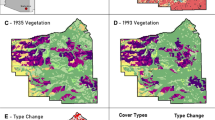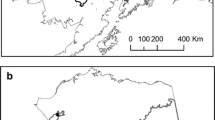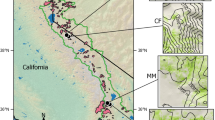Abstract
Context
Annual grass invasions often increase the frequency and extent of wildfire. Climate variability and fire history may have modifying effects on invasion success and its link to changing fire regimes.
Objective
Characterize the role of climate variability and fire history in vegetation shifts of an invaded desert landscape.
Method
Pre- and post-fire landscape vegetation greenness were assessed on multiple, independent wildfires in Mojave Desert shrublands using a 34 year record of normalized difference vegetation index (NDVI) derived from 1685 Landsat images and matched with a record of precipitation using linear regression.
Results
Annual maximum NDVI, and its annual variance of monthly maximum values, were significantly higher on post-fire than pre-fire landscapes. Additionally, post-fire landscapes showed greater sensitivity to antecedent precipitation received the previous 4 months than pre-fire and unburned landscapes. Ground surveys of vegetation indicate that post-fire landscapes show little indication of recovery of native shrub cover and density but instead are dominated by the exotic grass red brome (Bromus rubens L.). Increased NDVI sensitivity to precipitation is likely related to the growth of red brome, which dominates burned landscapes. Record precipitation in the fall of 2004 contributed to the record NDVI values in 2005 likely driven by high density of red brome.
Conclusions
The heightened response of post-fire vegetation to extreme and more variable precipitation events appears to be contributing to the emergence of an invasive grass-fire cycle that constrains the re-establishment of fire sensitive native shrubs while reinforcing the dominance of exotic grasses.





Similar content being viewed by others
References
Abella SR (2009) Post-fire plant recovery in the Mojave and Sonoran Deserts of western North America. J Arid Environ 73:699–707
Abella SR, Embrey TM, Schmid SM, Prengaman KA (2012) Biophysical correlates with the distribution of the invasive annual red brome (Bromus rubens) on a Mojave Desert landscape. Invasive Plant Sci Manag 5:47–56
Agnew ADQ (1997) Switches, pulses and grazing in arid vegetation. J Arid Environ 37:609–617
Allen EB, Steers RJ, Dickens SJ (2011) Impacts of fire and invasive species on desert soil ecology. Rangel Ecol Manag 64:450–462
Allen PS, Meyer SE, Beckstead J (1995) Patterns of seed after-ripening in Bromus tectorum L. J Exp Bot 46:1737–1744
Balch JK, Bradley BA, D’Antonio CM, Gómez-Dans J (2013) Introduced annual grass increases regional fire activity across the arid western USA (1980–2009). Glob Change Biol 19:173–183
Beatley JC (1966) Ecological status of introduced brome grasses (Bromus Spp.) in desert vegetation of southern Nevada. Ecology 47:548–554
Beatley JC (1967) Survival of winter annuals in the northern Mojave desert. Ecology 48:745–750
Beatley JC (1969) Biomass of desert winter annual plant populations in southern Nevada. Oikos 20:261–273
Beatley JC (1976) Rainfall and fluctuating plant populations in relation to distributions and numbers of desert rodents in southern Nevada. Oecologia 24:21–42
Bedford DR, Miller DM, Schmidt KM, Phelps GA (2009) Landscape-Scale relationships between surficial geology, soil texture, topography, and creosote bush size and density in the Eastern Mojave Desert of California. In: Webb RH, Fenstermaker LF, Heaton JS, Hughson DL, McDonald EV, Miller DM (eds) The Mojave Desert: ecosystem processes and sustainability. University of Nevada Press, Reno, Nevada 89577 USA, pp 252–276
Bond W, Keeley J (2005) Fire as a global “herbivore”: the ecology and evolution of flammable ecosystems. Trends Ecol Evol 20:387–394
Bradley BA, Mustard JF (2005) Identifying land cover variability distinct from land cover change: cheatgrass in the Great Basin. Remote Sens Environ 94:204–213
Brooks ML (1999) Alien annual grasses and fire in the Mojave Desert. Madrono 46:13–19
Brooks ML (2002) Peak fire temperatures and effects on annual plants in the Mojave Desert. Ecol Appl 12:1088–1102
Brooks ML (2012) Effects of high fire frequency in creosote bush scrub vegetation of the Mojave Desert. Int J Wildland Fire 21:61–68
Brooks ML, Berry KH (2006) Dominance and environmental correlates of alien annual plants in the Mojave Desert, USA. Journal of Arid Environments 67(Supplement):100–124
Brooks ML, Matchett JR (2006) Spatial and temporal patterns of wildfires in the Mojave Desert, 1980–2004. J Arid Environ 67:148–164
Brooks ML, D’Antonio CM, Richardson DM, Grace JB, Keeley JE, DiTomaso JM, Hobbs RJ, Pellant M, Pyke D (2004a) Effects of Invasive Alien Plants on Fire Regimes. BioScience 54:677. doi:10.1641/0006-3568(2004)054[0677:EOIAPO]2.0.CO;2
Brooks ML, Matchett J, Wallace C, Esque T (2004b) Fuels mapping and fire hazard assessment in a desert ecosystem. Arid Lands Newslett 55:1–5
Bukowski BE, Baker WL (2012) Historical fire regimes, reconstructed from land-survey data, led to complexity and fluctuation in sagebrush landscapes. Ecol Appl 23:546–564
Cave GH, Patten DT (1984) Short-term vegetation responses to fire in the upper Sonoran Desert. J Range Manag 37:491–496
Chambers JC, Bradley BA, Brown CS, D’Antonio C, Germino MJ, Grace JB, Hardegree SP, Miller RF, Pyke DA (2013) Resilience to stress and disturbance, and resistance to Bromus tectorum L. Invasion in cold desert shrublands of Western North America. Ecosystems 17:360–375. doi:10.1007/s10021-013-9725-5
D’Antonio CM, Vitousek PM (1992) Biological invasions by exotic grasses, the grass/fire cycle, and global change. Annu Rev Ecol Syst 23:63–87
Easterling DR, Meehl GA, Parmesan C, Changnon SA, Karl TR, Mearns LO (2000) Climate extremes: observations, modeling, and impacts. Science 289:2068–2074
Eidenshink J, Schwind B, Brewer K, Zhu ZL, Quayle B, Howard SM (2007) A project for monitoring trends in burn severity. J Assoc Fire Ecol 3:3
Engel EC, Abella SR (2011) Vegetation recovery in a desert landscape after wildfires: influences of community type, time since fire and contingency effects. J Appl Ecol 48:1401–1410
Esque TC, Kaye JP, Eckert SE, DeFalco LA, Tracy CR (2010a) Short-term soil inorganic N pulse after experimental fire alters invasive and native annual plant production in a Mojave Desert shrubland. Oecologia 164:253–263
Esque TC, Young JA, Tracy CR (2010b) Short-term effects of experimental fires on a Mojave Desert seed bank. J Arid Environ 74:1302–1308
Greenberg JA (2014) Spatial tools: R functions for working with spatial data
Hamerlynck EP, Huxman TE, Loik ME, Smith SD (2000) Effects of extreme high temperature, drought and elevated CO2 on photosynthesis of the Mojave Desert evergreen shrub, Larrea tridentata. Plant Ecol 148:183–193
Haubensak K, D’Antonio C, Wixon D (2009) Effects of fire and environmental variables on plant structure and composition in grazed salt desert shrublands of the Great Basin (USA). J Arid Environ 73:643–650
Hereford R, Webb RH, Longpre CI (2006) Precipitation history and ecosystem response to multidecadal precipitation variability in the Mojave Desert region, 1893-2001. J Arid Environ 67:13–34
Hobbs RJ, Huenneke LF (1992) Disturbance, diversity, and invasion: implications for conservation. Conserv Biol 6:324–337
Horn KJ, Nettles R, St. Clair SB (2015a) Germination response to temperature and moisture to predict distributions of the invasive grass red brome and wildfire. Biol Invasions 17(6):1849–1857
Horn KJ, Wilkinson J, White, St. Clair SB (2015b) Desert wildfire impacts on plant community function. Plant Ecol 216:1623–1634
Huenneke LF, Anderson JP, Remmenga M, Schlesinger WH (2002) Desertification alters patterns of aboveground net primary production in Chihuahuan ecosystems. Glob Change Biol 8:247–264
Hunter R (1991) Bromus invasions on the Nevada Test Site: present status of B. rubens and B. tectorum with notes on their relationship to disturbance and altitude. West North Am Nat 51:176–182
IPCC (2007) Climate Change 2007: The physical science basis. contribution of working group I to the fourth assessment report of the intergovernmental panel on climate change. Cambridge University Press, Cambridge and New York
Jensen JR (2007) Remote sensing of the environment: an earth resource perspective. Pearson Prentice Hall, Upper Saddle River
Kawabata A, Ichii K, Yamaguchi Y (2001) Global monitoring of interannual changes in vegetation activities using NDVI and its relationships to temperature and precipitation. Int J Remote Sens 22:1377–1382
Keeley JE (2009) Fire intensity, fire severity and burn severity: a brief review and suggested usage. Int J Wildland Fire 18:116–126
Kitzberger T, Brown PM, Heyerdahl EK, Swetnam TW, Veblen T (2007) Contingent Pacific-Atlantic Ocean influence on multicentury wildfire synchrony over western North America. Proc Natl Acad Sci 104:543–548
Knapp AK, Fay PA, Blair JM, Collins SL, Smith MD, Carlisle JD, Harper CW, Danner BT, Lett MS, McCarron JK (2002) Rainfall variability, carbon cycling, and plant species diversity in a mesic grassland. Science 298:2202–2205
Lei SA (1999) Postfire woody vegetation recovery and soil properties in blackbrush (Coleogyne ramosissima Torr.) shrubland ecotones. J Arizona-Nevada Acad Sci 32:105–115
Lotsch A, Friedl MA, Anderson BT, Tucker CJ (2003) Coupled vegetation-precipitation variability observed from satellite and climate records. Geophys Res Lett 30:1774
Marlon JR, Bartlein PJ, Walsh MK, Harrison SP, Brown KJ, Edwards ME, Higuera PE, Power MJ, Anderson RS, Briles C, Brunelle A, Carcaillet C, Daniels M, Hu FS, Lavoie M, Long C, Minckley T, Richard PJH, Scott AC, Shafer DS, Tinner W, Umbanhowar CE, Whitlock C (2009) Wildfire responses to abrupt climate change in North America. PNAS 106:2519–2524. doi: 10.1073/pnas.0808212106
Miller DM, Bedford DR, Hughson DL, McDonald EV, Robinson SE, Schmidt KM (2009) Mapping Mojave Desert Ecosystem Properties with surficial geology. In: The Mojave Desert: ecosystem processes and sustainability. University of Nevada Press, Reno, pp 225–251
Paruelo J, Tomasel F (1997) Prediction of functional characteristics of ecosystems: a comparison of artificial neural networks and regression models. Ecol Model 98:173–186
Piñeiro G, Oesterheld M, Paruelo JM (2006) Seasonal variation in aboveground production and radiation-use efficiency of temperate rangelands estimated through remote sensing. Ecosystems 9:357–373
Rao LE, Allen EB (2010) Combined effects of precipitaiton and nitrogen deposition on native and invasive winter annual production in California deserts. Oecologia 162:1035–1046
Ravi S, D’Odorico P (2009) Post-fire resource redistribution and fertility island dynamics in shrub encroached desert grasslands: a modeling approach. Landscape Ecol 24:325–335
Redmond KT (2009) Historic Climate Variability in the Mojave Desert. In: Webb RH, Fenstermaker LF, Heaton JS, Hughson DL, McDonald EV, Miller DM (eds) The Mojave Desert: ecosystem processes and sustainability. University of Nevada Press, Reno, Nevada 89577 USA, pp 11–30
Reid CR, Goodrich S, Bowns JE (2008) Cheatgrass and red brome; the history and biology of two invaders. In: Proceedings—Shrublands under fire: disturbance and recovery in a changing world. U.S. Department of Agriculture, Forest Service, Rocky Mountain Research Station, pp 27–32
Salo LF (2004) Population dynamics of red brome (Bromus madritensis subsp. rubens): times for concern, opportunities for management. J Arid Environ 57:291–296
Schmidtlein S, Feilhauer H, Bruelheide H (2012) Mapping plant strategy types using remote sensing. J Veg Sci 23:395–405
Schwinning S, Sandquist DR, Miller DM, Bedford DR, Phillips SL, Belnap J (2011) The influence of stream channels on distributions of Larrea tridentata and Ambrosia dumosa in the Mojave Desert, CA, USA: patterns, mechanisms and effects of stream redistribution. Ecohydrology 4:12–25
St. Clair SB, Sudderth EA, Fischer ML, Torn MS, Stuart SA, Salve R, Eggett D, Ackerly D (2009) Soil drying and nitrogen availability modulate carbon and water exchange over a range of annual precipitation totals and grassland vegetation types. Global Chang Biol 15:3018–3030
St. Clair SB, O’Connor R, Gill R, McMillan B (2016) Biotic resistance and disturbance: rodent consumers regulate post-fire plant invasions and increase plant community diversity. Ecology 97:1700–1711
Steers RJ, Allen EB (2011) Fire effects on perennial vegetation in the Western Colorado Desert, USA. Fire Ecol 7:59–74
Stringham TK, Krueger WC, Shaver PL (2003) State and transition modeling: an ecological process approach. J Range Manag 56:106–113
Sun Y, Solomon S, Dai A, Portmann RW (2007) How often will it rain? J Clim 20:4801–4818
Vamstad MS, Rotenberry JT (2010) Effects of fire on vegetation and small mammal communities in a Mojave Desert Joshua tree woodland. J Arid Environ 74:1309–1318
Verón SR, Paruelo JM (2010) Desertification alters the response of vegetation to changes in precipitation. J Appl Ecol 47:1233–1241
Vitousek PM, D’Antonio CM, Loope LL, Rejmanek M, Westbrooks R (1997) Introduced species: a significant component of human-caused global change. N Z J Ecol 21:1–16
Westerling AL, Gershunov A, Brown TJ, Cayan DR, Dettinger MD (2003) Climate and wildfire in the western United States. Bull Am Meteorol Soc 84:595–604
Acknowledgements
We gratefully acknowledge Drs. Steven Petersen and Ryan Jensen for reviewing this manuscript along with the significant contributions of anonymous reviewers. We express appreciation for the use of Brigham Young University’s Lytle Ranch Preserve, which provided accommodations while working at field sites. This research was funded by the Sant Educational Endowment for a Sustainable Environment, the Redd Center, the United States Department of Agriculture NIFA award number 2010-04092, and the United States Department of Interior BLM.
Author information
Authors and Affiliations
Corresponding author
Rights and permissions
About this article
Cite this article
Horn, K.J., St. Clair, S.B. Wildfire and exotic grass invasion alter plant productivity in response to climate variability in the Mojave Desert. Landscape Ecol 32, 635–646 (2017). https://doi.org/10.1007/s10980-016-0466-7
Received:
Accepted:
Published:
Issue Date:
DOI: https://doi.org/10.1007/s10980-016-0466-7




